The Next Revolution in Astronomy: Gravitational Waves
February 2016 marks one of the biggest discoveries in cosmology and astronomy: the LIGO team annouced that they'd detected gravitational waves, 100 years after Albert Einstein predicted them. Scientists believe this could revolutionise how we study the universe. But what are these gravitational waves? How were they detected? And how is the discovery changing our understanding of cosmos? Graihagh Jackson finds out...
In this episode
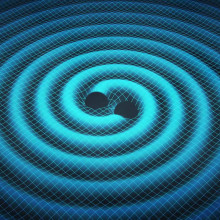
03:26 - What are gravitational waves?
What are gravitational waves?
with Various
Scientists annouced the detection of these elusive ripples in spacetime, 100 years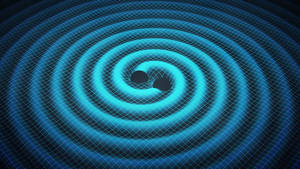 after Albert Einstein predicted them, but what are they? And why has it taken so long to find them? With the help of David Marsh, Sheila Rowan, Jon Kaufman and Norna Robertson, Graihagh Jackson journeys through the cosmos to find out...
after Albert Einstein predicted them, but what are they? And why has it taken so long to find them? With the help of David Marsh, Sheila Rowan, Jon Kaufman and Norna Robertson, Graihagh Jackson journeys through the cosmos to find out...
Scientist - Ladies and Gentleman, we have detected gravitational waves. We did it.
[Applause]
Sheila - We did a lot of running from office to office telling saying have you seen this. You know it's amazing so it was pretty fantastic.
Jon Kaufman - We'll have a whole new way to look at our universe which is pretty exciting.
Norna Robertston - It's as if we are now listening to the sky as well as seeing, so it's going objects that are different, that can't be seen in any other way.
David Marsh - And we can see some cool things like black holes colliding. It's really opening up of a new era.
Graihagh - ...and given that this podcast is all about astronomy, it would be criminal of me NOT to be talking about it.
The case was made even more strongly when I got an email from Robin Laren...
Robin - It wasn't more than a week ago that there was lots of noise and brew ha ha about these gravitational waves and, of course, I didn't understand anything about it, about what's so significant about them. But it seemed like something really nifty and something that Einstein said a hundred years ago that there shall be gravitational waves. It made sense in my mind, and then I remembered another podcast where they tried to explain Einstein's general relativity that there isn't really such a thing as gravity. And this comes from the same Einstein that sort of said that there is gravitational waves and then there is no such thing. So it's just curves in space and then it just doesn't make any sense to me any more.
Graihagh - You're sort of left feeling like what the heck is going on here!
Robin - It's the same guy - he was a genius so he sort of should have his facts straight.
Graihagh - So this month on Naked Astronomy - gravitational waves, with a hint of the big bang.
Okay. Gravitational waves. Stripped down bare. Here we go, they are like waves in the sea, or the ripples from a stone dropped into a pond. There's a ruddy great big event in space, like black holes colliding or even the birth of our universe at the big bang - if we're continuing with our pond analogy, a massive stone, heck a boulder! - would have dropped in and you can immagine loads of ripples propagating out and this disturbance creates waves and ripples across the fabric of space time
So, if you dance around now, (like me) dun dun dun duner you're actually create gravitational waves! David Marsh at Cambridge University and myself thought this idea was pretty cool.
David - Yes, it is pretty cool, yes. Undetectably small but, nevertheless, you are creating gravitational waves tonight.
Graihagh - The effect of this ripple bends and stretch space and time and the one detected shook detectors for 20 milli seconds... so does that mean as a gravitational waves passes through me I get momentarily skinnier and taller? Or fatter and shorter? Albeit for a fraction of a second? Jon Kauffman, University of Caligornia, San Deigo...
Jon - Yes, but this is sort of the funny part - and this what really makes LIGO so incredible is that the ways in which you would tell if you were taller, shorter, or fatter or skinnier would also stretch, so your ruler would stretch...
Graihagh - And that's in part why they've been so difficult to detect - massive huge ruddy great big things only distort spacetime by the width of a proton. Despite being seemingly unimaginable, TINY objects, Einstein somehow dreamt them up....
Nona - Gravitational waves are a prediction from Einstein's general theory of relativity which he produced a hundred years ago, and this was one of the final parts of his theory which had yet to be proven. And now that we have made this dissection, we have proved that gravitational waves exist a hundred years after their prediction.
Graihagh - Very timely indeed isn't it. Was that deliberate?
Nona - No, it's not deliberate, of course, but it is very timely and it is wonderful that it has happened on the hundredth anniversary.
Norna Robertson there from Caltech there (btw, we'll be hearing more from all of these guys later in the programme in more detail so, just bare with me)
Now, Isaac Newton explained how an apple fell from a tree - that objects with mass were attracted to each other - but not why. This is where Einstein comes in. Einstein said 'hey, the reason they're attracted to each other is because massive objects bend the fabric of space time... David Marsh again...
David - One way to think about it is that space time is like a mattress, if you wish, and if you place a very heavy object on this mattress, it will sink down and the mattress around it will bend upwards. So that's what happens in gravity. So if you have a heavy object (any heavy object) like me...
Graihagh - Or even something like the sun?
David - Or even the sun - even a little bit more heavy...
Graihagh - Just a little bit...
David - Yes.... bends space time around it.
Graihagh - This takes us to Robin's question about gravity, Einstein and Newton. Newton thought gravity was a force; Einstein thought that massive objects - sun, moon and stars and in David's analogy, a bowling ball - create a curvature in spacetime and this is what we feel as gravity.
In general relativity, gravity is not a force between masses. It's an effect of the warping of spacetime.
If we return to gravitational waves - when massive objects collide, they create ripples across the fabric of spacetime, just like if you dropped that bowling ball on a sheet. We have been trying to detect these things, these ripples, for donkeys years - people have spent their entire careers working on this! And this month, the LIGO team found them.
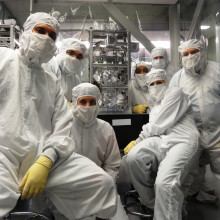
07:29 - What have the LIGO team detected?
What have the LIGO team detected?
with Professor Norna Robertson, California Institute of Technology & University of Glasgow
The LIGO team announced the results from the States but there was a special 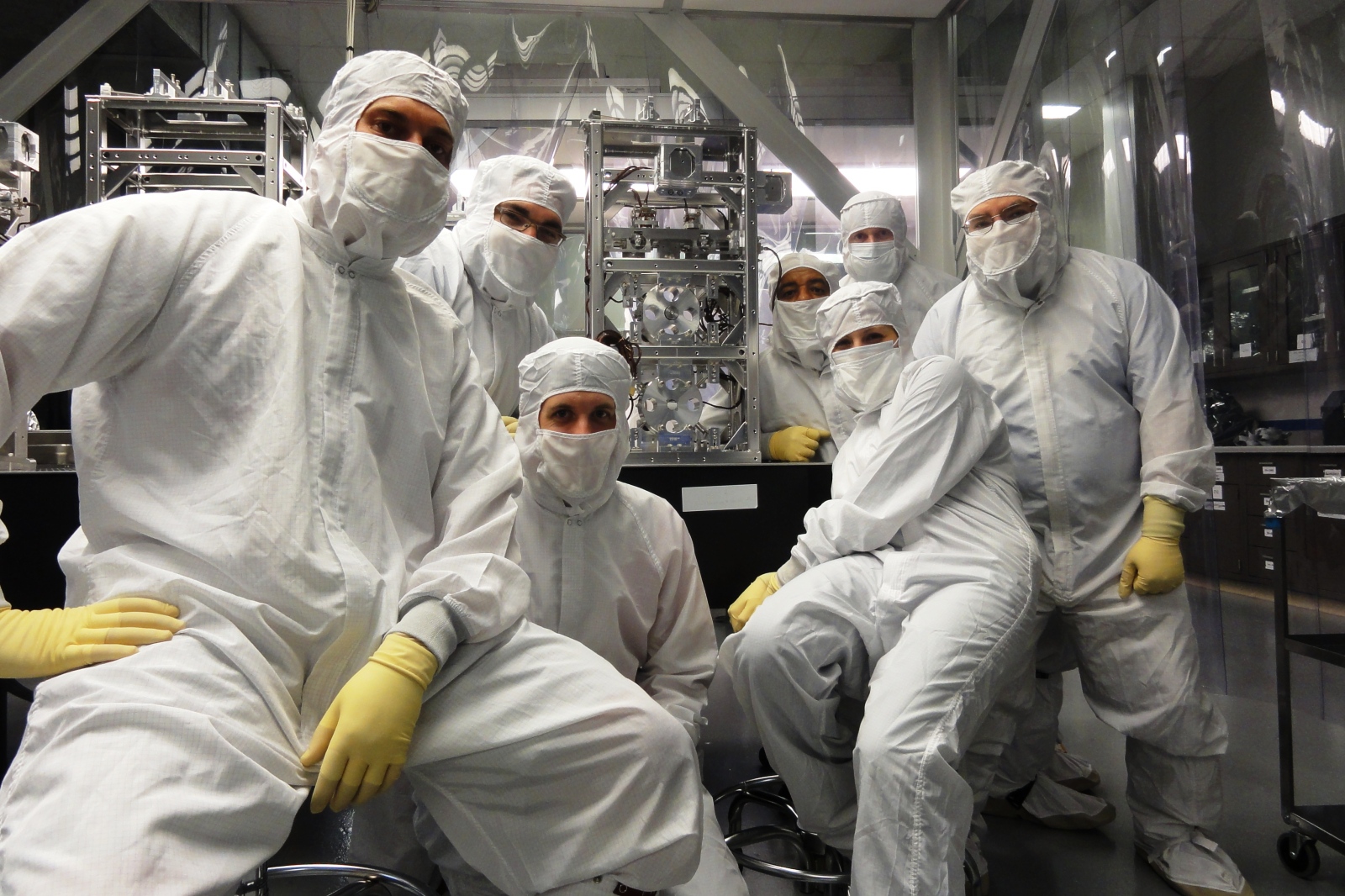 meeting for British-based journalists and academics in London and this is where Graihagh Jackson met Norna Robertson from Cal-tech who's helped to detect these elusive things...
meeting for British-based journalists and academics in London and this is where Graihagh Jackson met Norna Robertson from Cal-tech who's helped to detect these elusive things...
Announcement - Ladies and Gentlemen. We have detected gravitational waves. We did it.
[Applause]
Graihagh - But how did they do it?
They announced the results from the States but there was a special meeting for us Brits in London and this is where I met Norna Robertson from Cal-tech who's helped to detect these elusive things...
Norna - The event that we saw was two black holes which were orbiting each other in a double system. So that they're going round each other and they're also moving toward each other because they're losing energy as they're orbit each other and so they speed up and go round and round faster and faster until they finally merge. And it's that final inspiral and merger which happens in a fraction of a second that produces a big burst of gravitational waves.
Graihagh - And that rippled across the universe to us. How long does it take to reach us though?
Norna - The event happened something like one billion years ago, a billion light years away and it's taken all that time to ripple across space towards us and pass through the Earth on September 14th, 2015.
Graihagh - It's quite remarkable really, isn't it?
Norna - It is remarkable. It's wonderful. There have been many, many people involved in developing detectors and developing all the analysis techniques and, for all of us, this is really a momentous occasion.
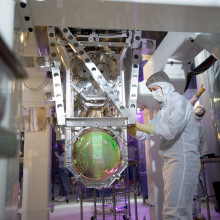
09:00 - How did LIGO detect them?
How did LIGO detect them?
with Professor Sheila Rowan, University of Glasgow
Given that these gravitational waves only distort spacetime by less than the width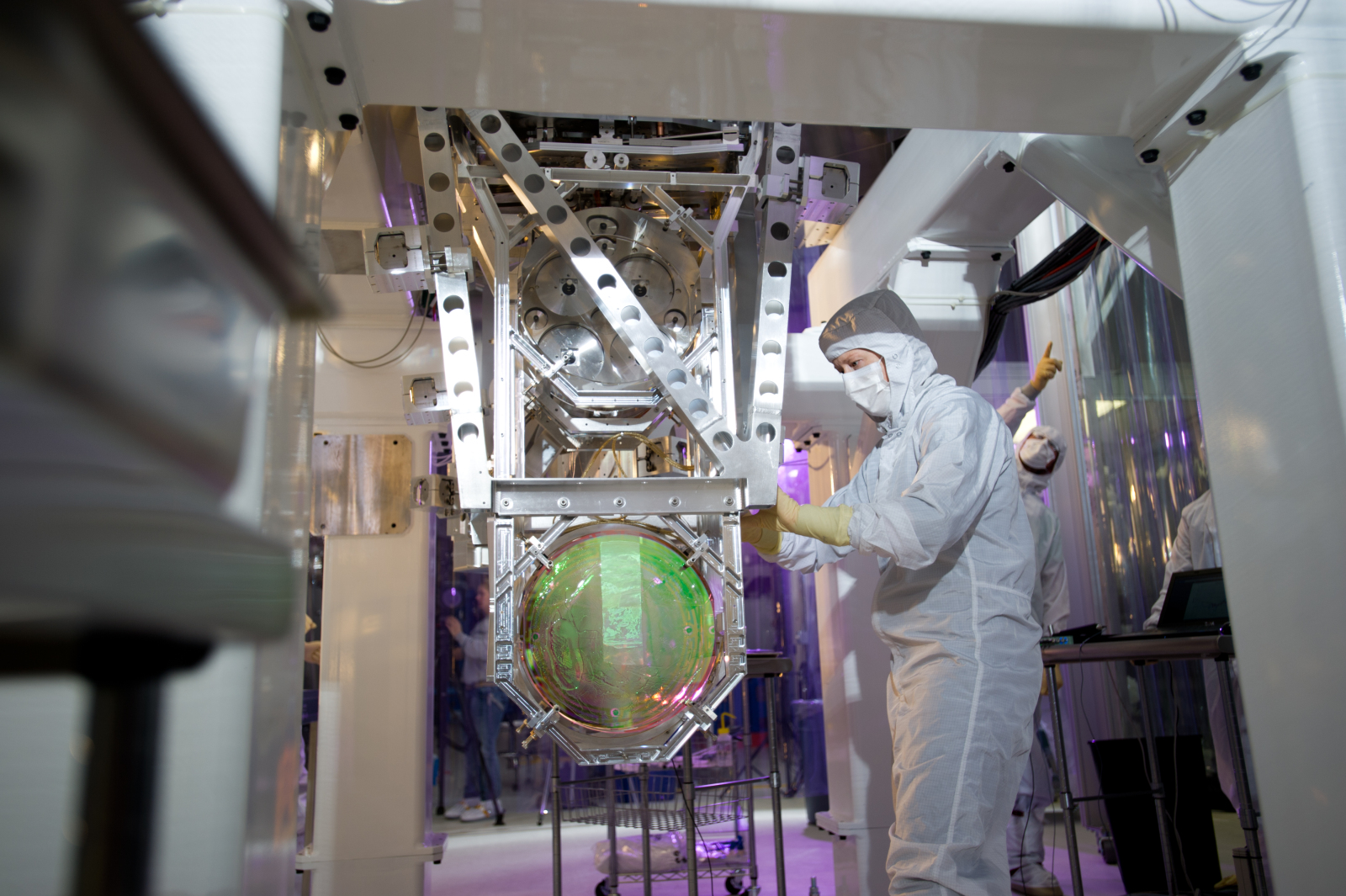 of a proton, how did were they detected? Sheila Rowan talked Graihagh Jackson through the a-LIGO set up...
of a proton, how did were they detected? Sheila Rowan talked Graihagh Jackson through the a-LIGO set up...
Sheila - When they're produced, of course, there's a huge amount of energy as two black holes collide but then that's got to spread out and travel across the universe. So, by the time it gets to us here on Earth, it's a tiny signal and that means it's hard for us to build instruments that are sensitive enough to do that. And the way we do it is we actually take light from a laser, we split that laser light into two and we send it out along, actually, two four kilometer long paths, it hits mirrors at the ends of those paths. Those mirrors send the laser light back, the light then adds up (09.52) and whether it adds up so that you get a bright spot or whether it cancels itself out and you get a dark spot, depends on how far the light has travelled on that four kilometer path. Now what a gravitational wave does when it arrives is it changes the lengths of the arms (what we call the arms) the paths that the light has travelled and, fundamentally, it does that by shaking the mirrors that we've put down. The trouble is it doesn't really shake them very much - it shakes those mirrors by about 1/10,000 of the size of a proton inside an atom...
Graihagh - So how would you ever measure that?
Sheila - It's a big challenge and that's one of the reasons it's taken decades of work to do this, and there are various things that are key. One incredibly important thing, of course, is to take those mirrors that the gravitational wave's going to shake and make sure that nothing else shakes them. So, we couldn't just sit them on the ground because the ground moves all the time. There's what we call seismic motion - the ground shakes. It shakes due to far away earthquakes; it shakes just due to people driving cars past, so we can't do that. Instead what we do is we take the mirrors and we actually hand them and we suspend them, in fact, on very fine ultrapure glass fibres. And why do we do that? Well hanging the mirrors actually isolates them from the ground. If you hang something you build a mechanical filter; it filters out noise, the ground noise. But, those glass fibres are special because every single atom in those mirrors, and in the fibres that hand it, it's shaking slightly. It's just at room temperature - everything that has is just at room temperature is shaking a little bit. That's what we call thermal energy and making these fibres out of glass and these mirrors out of glass - and to give you some perspective those mirrors are 40 kilos, they're not small - both isolates, filters out the ground motion and keeps that thermal motion low. So what we've done is make mirrors that are almost motionless; they're hanging there just waiting for a gravitational wave to come by and shake them.
Graihagh - Wow! So we've detected one of these gravitational waves. It took what 20 milliseconds? Is that how long shook the mirror for, yes? We've detected one of them - when's the next one?
Sheila - That's a good question and we don't know the answer to that yet. We do have more data that we've taken. The event we detected here came from some fraction of the data that we've got so far and that's all we've had time to analyse. We do have more data, we just haven't had time to look in there yet and see what's in there. So we can check that and announce that and if there's anything there or see it. So, we don't know. You'll have to wait to hear back from us but we're looking hard.
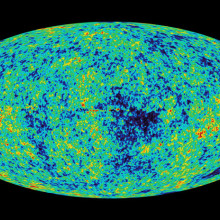
13:05 - But didn't BICEP detect them before?
But didn't BICEP detect them before?
with Dr David Marsh, University of Cambridge and Dr Jon Kaufman, University of California, San Diego
In 2013, a group of American astronomers who work with a telescope called 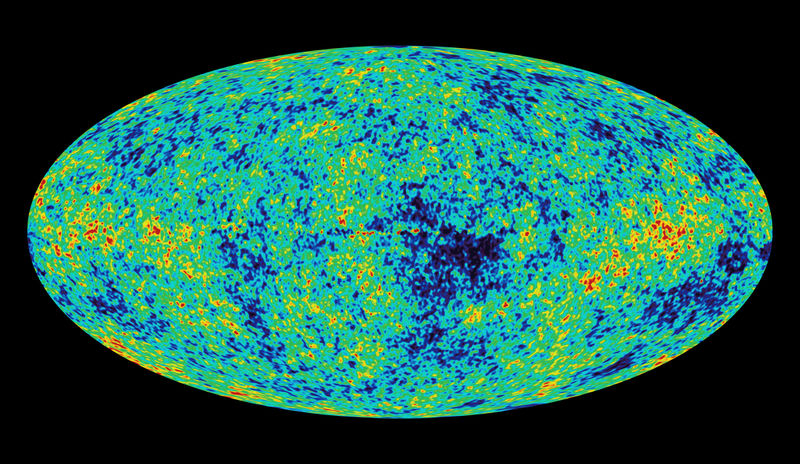 BICEP annouced they had found gravitational waves. How are these different to what LIGO have found? To spot the difference, David Marsh and Jon Kaufman take Graihagh Jackson back to the Big Bang by looking through the Naked Scientists archive...
BICEP annouced they had found gravitational waves. How are these different to what LIGO have found? To spot the difference, David Marsh and Jon Kaufman take Graihagh Jackson back to the Big Bang by looking through the Naked Scientists archive...
Chris - In March this year, the U.S. BICEP team of astronomers claimed to have found the long sought evidence for cosmic inflation - one of the mechanisms that underpins what happened in a fraction of a second after the big bang, when the universe began. Inflations been theorised for decades and the results caused quite a big stir in the scientific community with talk of Nobel Prizes being awarded to the astronomers concerned...
Graihagh - The evidence Chris was referring to was an indirect detection of gravitational waves and it was found by a team of american astronomers using a telescope called BICEP. But these waves are different to the waves that have been announced this week and actually, the BICEP evidence has since been called into question by another satellite called Planck. So what the heck is going on here? How can these gravitational waves have the same name but could be different? And why didn't scientists just give them another name.
To spot the difference, we have to return to the big bang (I did promise some big bang, didn't I?) and and a theory called inflation - this explains how the universe went from being something teny, tiny tiny, to the massive expanse that our universe is today...
David - So okay. My name is David Marsh and my title is Stephen Hawking Advanced Fellow/Senior Research Associate at the Centre for Theoretical Cosmology at the Department of Applied Mathematics & Theoretical Physics at the University of Cambridge.
Graihagh - I feel like I've got your postal address, yes? That's a big long title...
David - That's a big long title, yes.
Graihagh - Does that mean that your work with Stephen Hawking then?
David - I met him but I don't work with him at the moment, no.
Graihagh - Oh well. There you go then.
David - What inflation is, is an expansion of the universe but it expands at an accelerated pace. So each block of space at any given moment of time creates another block of the same size and then those two blocks each creates one block, and then you have four blocks, and then these four create another four, and then these eight create another eight, and so forth.
Graihagh - Your maths is much better than mine...
David - So it's an exponential expansion of space. Inflation is driven by some energy density and quantum fluctuation in this energy density, on a very small scale, gets stretched during inflation because space expands and everything gets stretched with it. So in the end, these quantum fluctuations can become as big as the universe.
Graihagh - A quantum fluctuation is a change in the amount of energy in a point in space for a really period of time. Why it's important is because these tiny changes in energy were the seed of matter and structure in our universe. In other words - these fluctuations created galaxies, stars, planets and, as it happens, gravitational waves. These tiny fluctuations have now been stretched with inflation and are absolutely huge, and pretty much undetectable, as David was just saying...
David - So in the end, these quantum fluctuations can become as big as the universe, or even bigger.
Graihagh - That a bit mindboggling.
David - It is quite, yes.
Graihagh - How do we know that they're there if they're on that sort of scale?
David - Yes, so that's the thing. If we wouldn't have any observational evidence for it most of us would have just dismissed this as a theory. But now the funny thing is about this (04.12) is that in the theory of inflation, these stretched quantum fluctuations is what is responsible to the small temperature fluctuations that we see in different directions of the sky. So when we look at the sky at microwave wavelengths, we would see cosmic microwave background and it would seem almost completely smooth. Almost having the same temperature everywhere and so we can compute the temperatures to 2.7 kelvin so, -271 degrees.
Graihagh - Pretty cold then?
David - Cold, yes. And then you can compute it - first, second, third, forth, and at the fifth digit it starts to vary if you look in different directions of space. So at that level of accuracy or at that level of the temperature, it starts to fluctuate in different directions.
Graihagh - And you know who's looking up at the sky to the cosmic microwave background for days on end trying to detect some evidence for inflation with gravitational waves? Meet Jon Kaufman, from the University of California, San Diego. The name of the telescope he uses is called BICEP, which makes Jon, BICEP man in my eyes....
Jon - You know the inflation theory - the sort of bang behind the big bang - our best understanding for how the universe came to be. And so this would create some gravitational waves rippling throughout the universe. We don't look today using something like LIGO, we look about 13.8 billion years ago when these waves would have been much stronger at the surface of last scattering. This cosmic microwave background which is the transition between the very, very hot, dense, early universe and the universe that's a lot more recognisable to what we see when we look out with our telescopes now.
Graihagh - In other words, these gravitational waves would have left an imprint on the CMB - hotter or colder patches - and this is what Jon is hunting for with the telescope BICEP, however, it's located in the rather inconvenient place, the south pole...
What you can hear is a video of Jon and colleagues heading out on a skidoo to the telescope. They're wearing so much clothing that not a bit of flesh is visible, despite it being a beautiful, blue-skied and sunny day.
Jon - It can be gruelling but I like it down there. It's so unique; it's really alien; you really feel like you're on a different planet; there's nothing recognisable. When you're at the south pole; there's no features; there's no plants; there's are animals; mean there's not insects. Imagine a world where there's no flies or spiders around.
Graihagh - What I want to know is why were'nt there any penguins?
Jon - Yes. Nothing can survive at the south pole.
Graihagh - So when you're looking at the cosmic microwave background (the CMB), what are you looking for?
Jon - Well what our telescope does is we look for correlations on our patch of sky and we measure the temperature of the cosmic microwave background, the E mode polarisation, and the B mode polarisation. So this is a very different kind of telescope than what you would imagine when you think of a big telescope. It's actually relatively small, you know, it's only a couple of metres high and about 30cms across the focal plane where all our detectors live, and it's not a big dish, it's a refractor kind of like what Galileo used to stare up at the sky. Just a couple of lenses and instead of an eyepiece it's, you know, these superconducting detectors, this advanced technology that we use, for example, for BICEP2. And so with BICEP we didn't detect anything, BICEP2 was already in the works, which was going to add about a factor of 10 in terms of sensitivity. So one year of BICEP2 measurement would be equal to 10 years of BICEP1 measurement.
Graihagh - And so this polarisation you're looking for - what's that?
Jon - How light is an electromagnetic radiation. It means that there's an oscillating electromagnetic field and if it has a preferred direction that it likes to oscillate. If you imagine if you hold and string and you wip your hand up and down, you are creating a wave on the string that's polarised in one direction - the up and down direction. If you wip your hand left and right, you'll create a polarised wave left and right. It just means that there's a preferential axis to the wave that you've generated.
Graihagh - Okay. And that's what you detected?
Jon - Right. Only gravitational waves can create B mode polarisation at this time, at this cosmic microwave background time. And it became clear relatively early on that we were seeing something, and none of us believed it. We all expected it was some sort of systematic contamination and so we set about, for a long time, to just try to convince ourselves that what we were seeing wasn't real. And all sorts of crazy ideas of what this could be, including one of my favourites, which is the communication satellite that we use for internet at south pole might have been interfering with our telescope. So we ruled that out - we ruled everything we could think of out. You know there were no bad ideas and when finally everything was ruled out it looked like this must be on the sky and so, of course, that was very exciting. None of us - you know the excitement took a long time to build up because we were so convinced it was wrong, that there was nothing there. And so even as we were writing the paper it was just sort of - you know well, all right, we see this thing, it looks like it's real, let's just move on. You know, we'll keep going - we'll keep doing science. And then of course we published and we made the announcement. It was very exciting and it was starting to hit me that this is something that people might be interested in. You know, people, not just us. Articles starting popping up - New York Times and NPR, everything. All sorts of news sources from reputable to crazy ones. We're all starting to talk about it and there was so much interaction going on that I was just too excited. I just wanted to like shout it from the mountaintop - and then things got very interesting.
Graihagh - Things did indeed get interesting. Why? Because of dust...yep, you heard me. Dust by supernovae, or comets and so on all create dust and this dust can create the same polarisation in the CMB as gravitational waves...
Jon - When BICEP was being conceived, the idea was you look at the most empty patch of the sky, and the question, of course, is what to do you mean by empty. And what we looked at were maps of dust and you know, you say here's a bit hole that's visible 24/7 from the south pole - lets do that. And what was done up until our measurement was you looked at the intensity of the dust, you expected some amount of polarisation and you calculated the level at which this would contaminate the signal and this was way, way below anything that we had seen. So all these were models but it all looked like this dust level would be tiny. Well what happened afterwards is that the measurements from the PLANCK satellite came in and they showed that, contrary to what we we thinking, the less intensity of dust you have, actually, the higher the polarisation fraction of the dust, which means it's worse. Now it doesn't mean if you look through the centre of the galaxy would be better because there's a lot of dust, but it does mean that out at the edges that we're looking at, the dust polarisation fraction is a lot higher than anyone expected. With our result, it really injected a lot of excitement into the field from external sources and then with the PLANCK controversy, of course, everyone likes a controversy, everyone likes a battle.
Graihagh - They sure do! But gravitational waves from recent events, like black holes, have been detected. This is one of the final bits of evidence for Einstein's theory of relativity so should Jon just pack his bags and be done? Nope, apparently not.
Jon - So these gravitational waves, the one that had experiments like BICEP and many others, are looking for... are pretty significant because they would be extreme evidence for the theory of inflation. And the theory of inflation is really - I mean there's a lot of evidence for it already but it is one of the most important - again I'm a little biased - but one of the most important theories that I think humankind has ever developed in the sense that it is sort of why are we here. You know, why does the universe look like it does? Why is it susceptible to stars, and galaxies, and habitable worlds, and life? How did the universe get here and inflation answers that. And so while there is a significant amount of evidence for it, the smoking gun of this has not been detected and that is these gravitational wave.
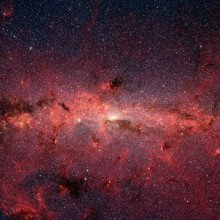
28:00 - What does it all mean for astronomy?
What does it all mean for astronomy?
with Professor Sheila Rowan, University of Glasgow
The fields of physics and astronomy is buzzing with the gravitational waves 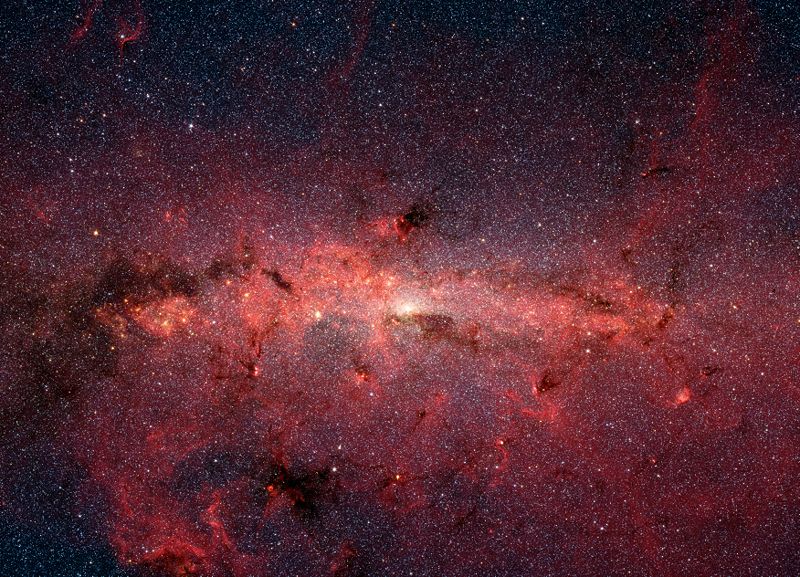 discovery but why? What are the wider implications for something like this? Graihagh Jackson sat down with Sheila Rowan to discuss how this will completely change our outlook on the universe...
discovery but why? What are the wider implications for something like this? Graihagh Jackson sat down with Sheila Rowan to discuss how this will completely change our outlook on the universe...
Sheila - These gravitational signals come from objects that may not emit any light. Black holes are called black for a reason. And two black holes colliding as we've detected, that's an event that might not produce any other optical signal or light, electromagnetic signals, X-rays. We just don't know that but it's possible it doesn't produce anything other than gravitational signals. And that means with these detectors, for the very first time, we can potentially sense a whole new set of events in the universe we couldn't see any other way. It also means there are other sorts of things out in the cosmos, some things that do produce optical or other light like supernovi. We so those with our current telescopes but, on the whole, we typically see the outside of a star exploding. We also get some particles called neutrinos that can come from that event that come from the inside but mostly we see the outside. Gravitational signals, because of the way they're produce, they come from the actual matter, the mass in that star exploding and so we might, actually, be able to get insights into the mechanism - what actually happens inside a star when it explodes. We've got theories for that right now but we don't actually know. We also may see whole different classes of things, types of events like neutron stars, very exotic stars. We don't know exactly what the material is inside a neutron star. It's under such pressure, high density. You couldn't even try and replicate that on earth - space for that is our laboratory. Neutron stars smashing into one another, a neutron star being eaten by a black hole. Those are all the fascinating things to try and see the gravitational signals from and as we improve our detectors, make them even more sensitive, we will be able to sense these kinds of things of an even larger volume of the universe. Right now we're just starting to be seeing these things, hearing these things. In fact, as time goes on we'll see further back in time and possibly one of the most interesting prospects is - what we don't know.
We have ideas about what might be out there but this is the first time we've been able to sense the gravitational universe. Every other time a telescopes turned on, whether it was an X-ray, UV, gamma ray, all those telescopes out there, people saw things they didn't expect. So, I think we might see gravitational waves from new things we haven't even thought of yet.
Graihagh - Sounds like something a bit out of scifi but the way I'm envisioning it, things you don't know, some of the unknown unkowns out there that we might finally be able to detect. A new era.
Sheila - I think that's right. It's a whole new way to do astronomy and I think it's going to be very exciting in years to come.
This is a fantastic field to work in. I know I wanted to be a scientist and wanted to be a physicist, I think since I was about nine years old and when I was young I couldn't think of anything more exciting to do in life than spend it studying these big questions and the universe. When you go out and look up, where it all come from? What's out there? HOw far does it go? And I've been lucky enough that I've been able to spend my life working in this area and doing that and I hope.... it's a fantastic life and I really hope that we'll see more smart young people coming into physics and wanting to follow this path because it's a fantastically enjoyable thing to do.
Graihagh - Watch this space then...
Sheila - Or as my colleague in Glasgow always says "watch this space time."









Comments
Add a comment